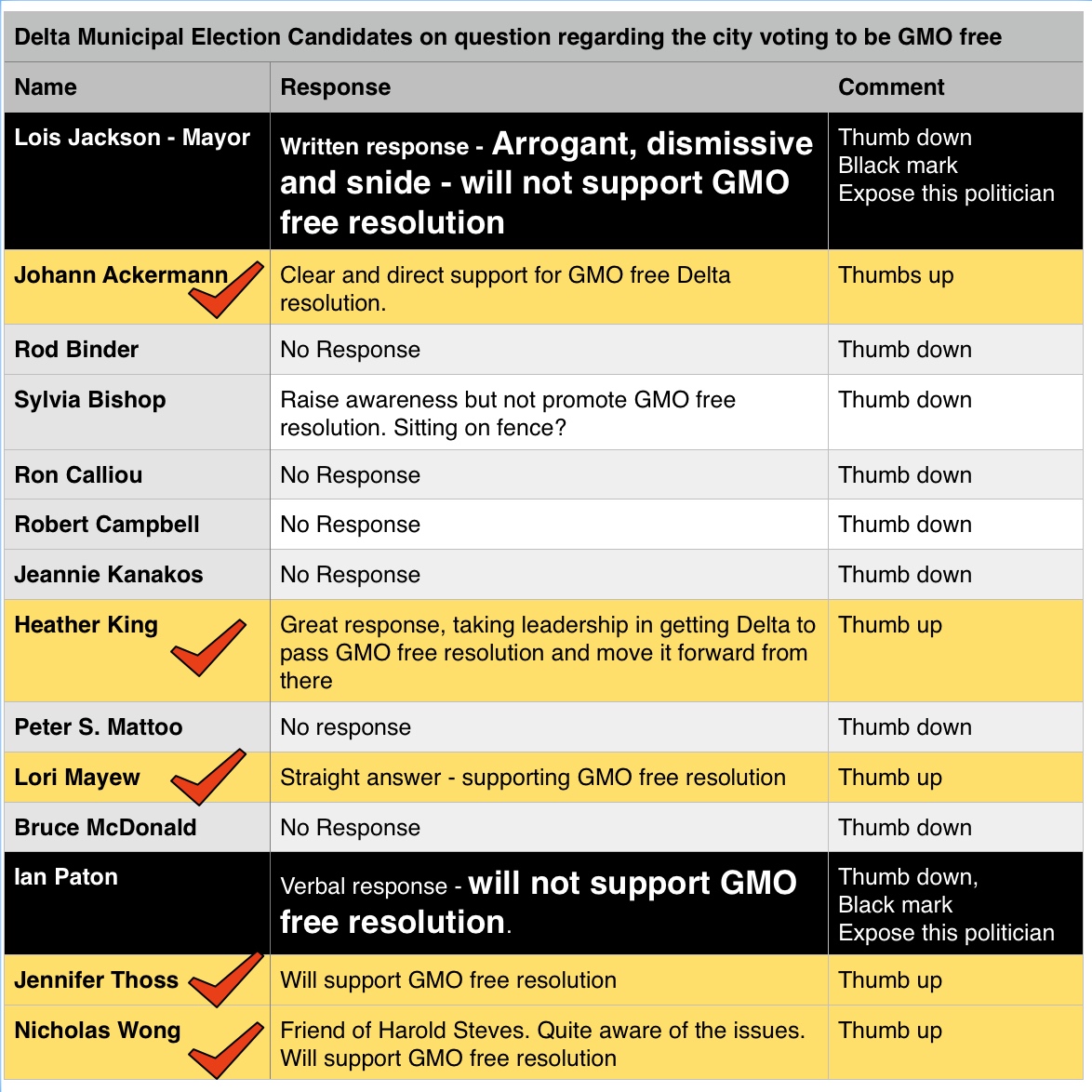
It’s a dog’s life !
Link to mayor Jackson blog.
Link to the School Board Election.
Fighting GMO and pesticide is the most important issue and threat facing Canada, only next to Climate change, and is related to it as well.
Fighting GMO requires standing up against the most powerful corporations and financial giants in a system that is skewered to siphon off more and more tax payers money to accumulate in the hands of ever more powerful few.
GMO surrenders Canadian food sovereignty and food security into the hands of a few foreign (US owned) corporations, and by extension, to US hegemony.
If a candidate is willing to stand up to those challenges and odds, it is my judgment that he or she can easily also handle all the other minor challenges that will come up, such as roads or parks and water service and schools and crime.
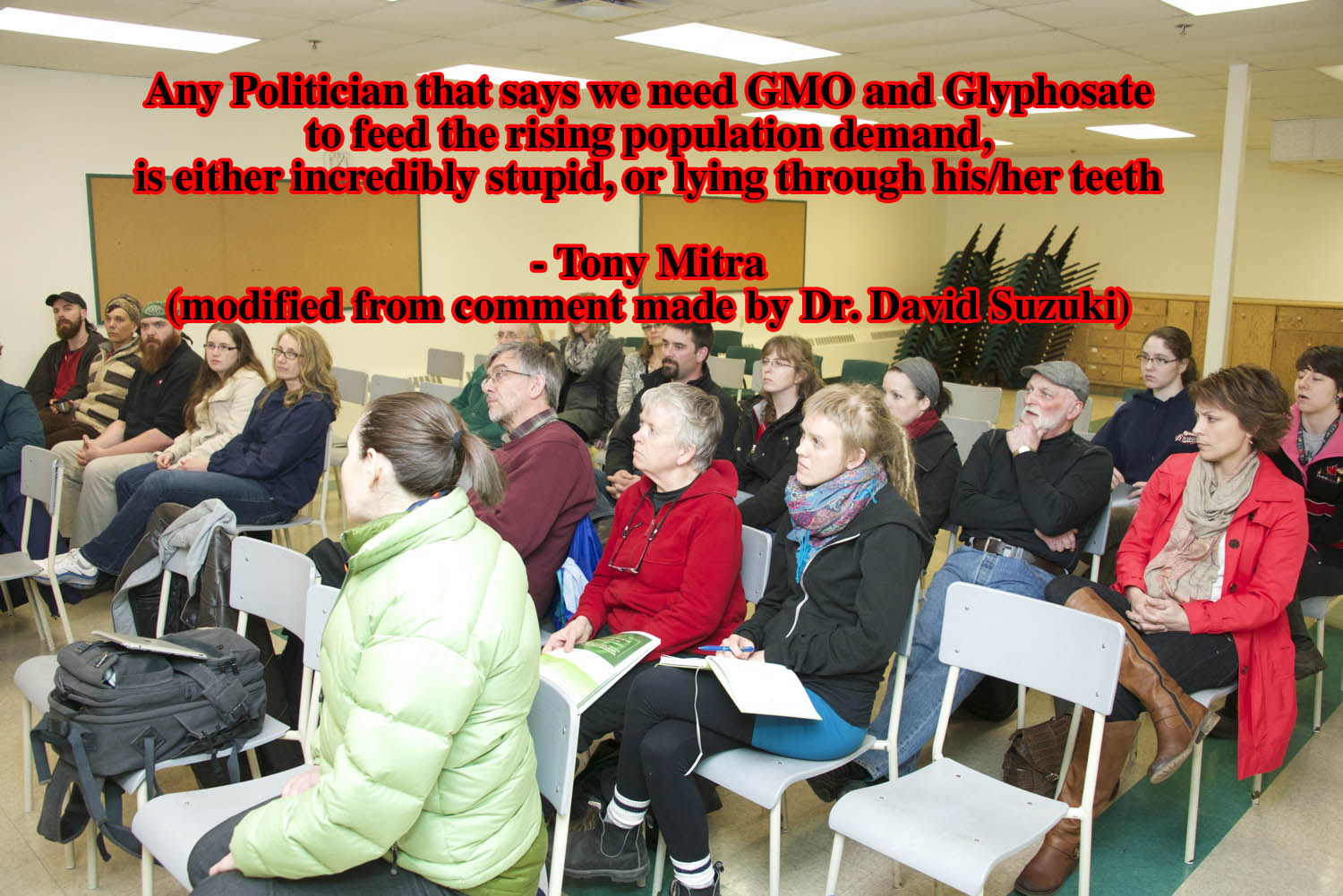
Many politicians are, when it comes to GMO, either incredibly stupid, or lying through their teeth, in my opinion, borrowing and modifying a comment originally made by Dr. David Suzuki.
And so, I focus on local Municipal elections, the only one where people can interact with their candidates and with their elected representatives, and have a reasonable chance of influencing the electoral outcome. It is the only level where corporate funding is not always working against you in overwhelming odds.
And thus, I asked the candidates by email on their stand on GMO. I attended the candidates meeting in Landner on the 23rd. I placed a question asking if they would support the resolution to declare Delta GMO free and follow the lead of other BC Municipalities.
I had the opportunity to hear the candidates, and interact with a few of them. I shall come back to fill this blog more with details – but meanwhile here are a few candidates and what I think about their candidacy, in pictures.
Its time to influence the elections to favour the concerns of the people, instead of greed of a few corporations. it is time to kick the bums off our Government. Its time to bring honest and incorruptible politicians that are not scared to call a spade a spade into our municipal governments. These honest people should protect Canadian land, air, water and people, who will promote small farmers that use their own seeds and traditional methods of growing healthy local food for the local people. We need an agriculture system where the money stays in the community, and not what we have now, eating our vegetables than come from California and Mexico, and eating pesticide laden unhealthy junk food produce that fatten the wallet of US corporate honchos and make Canadians sick, while driving Canadian small farmers into bankruptcy and extinction.
Time to boot the bums off our Government, save Canada and our future generation. Nothing more and nothing less.
![]()
Mayor Lois Jackson has finally sent a response in writing and in bold letters.
 I consider her response not only wrong in many ways, but also arrogant, dismissive and snide. Another issue is that she seems to indicate that it is the duty of the council of Delta to understand the science of GMO and then pass a judgment on it. This indication, if true, is another item I shall deal with separately, as to what should be the duty of a mayor and a city council on complex issues that are not just related to science, but also to seed freedom, food security, patenting of life forms by foreign corporations and using them to make all local competitive crops go extinct, and killing off all small farmers in Canada, and handing over the food industry to the stranglehold monopoly of a handful of foreign corporations, to name just a few. I suspect the Mayor, as an educated person capable of rational thinking, can easily understand these factores even if she does not understand GMO or pesticides in our soil and water and food, since the effects of this business model has been eating into Canadian agriculture for about 20 years now. And Canada does not have another 20 years for our politicians to finally come to grips with the situation.
I consider her response not only wrong in many ways, but also arrogant, dismissive and snide. Another issue is that she seems to indicate that it is the duty of the council of Delta to understand the science of GMO and then pass a judgment on it. This indication, if true, is another item I shall deal with separately, as to what should be the duty of a mayor and a city council on complex issues that are not just related to science, but also to seed freedom, food security, patenting of life forms by foreign corporations and using them to make all local competitive crops go extinct, and killing off all small farmers in Canada, and handing over the food industry to the stranglehold monopoly of a handful of foreign corporations, to name just a few. I suspect the Mayor, as an educated person capable of rational thinking, can easily understand these factores even if she does not understand GMO or pesticides in our soil and water and food, since the effects of this business model has been eating into Canadian agriculture for about 20 years now. And Canada does not have another 20 years for our politicians to finally come to grips with the situation.
These are not new questions since I sent emails to her in the past on these issues too, and never got a response. I wonder why she bothered to respond, that too in such an arrogant way, at this juncture. I am going to have fun responding to that letter in fuller detail on a separate blog. I take note of some of the terms she used, such as “Looking for attention“, “Bandwagon“, “Empty of information“.
The content of the letter deserves a more detailed response from me and will be covered in a separate blog all its own. Here I copy her message so the public can read it already, and form their own opinion on her attitude in dealing with questions that may be uncomfortable for her. I am also being requested by organizers in Ontario and Quebec to bring with me the letters from Councillor Bishop and Mayor Jackson as well as my replies (I have not yet penned my reply to Mayor Jackson, except a brief holding message, but hope to do so soon), in our workshop and presentation to the people, on how one might ask questions to local politicians and what kind of response might be expected. Quote
GREETINGS:
WELL, FIRSTLY MY NAME IS LOISŠ
SECONDLY, MAY I SAY THAT WE HAVE NOT BEEN USING PESTICIDES NOR
INSECTICIDES IN OUR PARKS FOR SEVERAL YEARS. WE BAN IT FROM BEING SOLD IN DELTA AND ENCOURAGE PEOPLE TO USE łNATURAL˛ METHODS TO KEEP DOWN GARDEN PESTS.
AS WITH MANY TOPICS THAT ARE BEING DISCUSSED TODAY IN THE MEDIA AND BY THE PUBLIC, GMO SEEMS TO BE ONE OF THEM. THIS ISSUE HAS NOT BEEN SCIENTIFICALLY PRESENTED TO OUR COUNCIL AND I HAVE ASKED OUR CHIEF ADMINISTRATIVE OFFICER, MR. GEORGE HARVIE TO BRING FORWARD GOOD SCIENTIFIC ANALYSIS FOR COUNCILąS PERUSAL.
I MUST ALSO SAY THAT I AM NOT A SCIENTIST NOR A CANADIAN FOOD INSPECTOR
NOR CANADIAN LEGISLATOR;THESE ARE VERY COMPLEX ISSUES AND I LOOK FORWARD TO RECEIVING CREDIBLE REPORTS TO OUR COUNCILąS ATTENTION.
AS FAR AS OTHER CITIES AND COMMUNITIES ARE CONCERNED, IT IS SO EASY FOR
SOME COUNCILąS TO SIMPLY JUMP AT AN ISSUE, (LOOKING FOR ATTENTION PERHAPS?) AND THEY JUMP ONTO A BANDWAGON WHICH IS EMPTYŠ EMPTY OF INFORMATION, SCIENCE AND UNDERSTANDING. OUR DELTA COUNCIL TAKES PRIDE IN ANALYZING THE ISSUE, SEARCHING OUT THE BEST INFORMATION, REFERRING IT TO EXPERTS, BEFORE WE łJUMP ONTO THE BANDWAGON˛.
AS AN EXAMPLE, I REFER TO THE ISSUE OF SHARK FIN SOUPŠ THIS WAS A FEDERAL IMPORTATION MATTER AND WE HAD NO JURISDICTION TO DISALLOW ITS IMPORTATION NOR SALE IN DELTA. WE DID HOWEVER, MAKE STRONG PRESENTATIONS TO MANY FEDERAL JURISDICTIONS WHO DID HAVE AUTHORITY. MANY COUNCILLORS AND COUNCILS CAME FORWARD CONDEMNING THE PRACTICE, HOWEVER, THE SUBJECT WAS AN EMOTIONAL ONE OVER WHICH LOCAL GOVERNMENT HAD NO JURISDICTION.
ANOTHER ISSUE WAS THE łBANNING OF NUCLEAR WEAPONS IN VANCOUVER˛ THERE WAS NO EFFECT OF THIS STATEMENT, AND IT WAS SIMPLY A STATEMENT BY A COUNCIL WHO HAD NO JURISDICTION OVER A MATTER.
THEREFORE, TO BE HONEST AND OPEN AND MAKING GOOD LEGISLATION ON AN ISSUE, I WILL AWAIT THE REPORTS FROM OUR STAFF AND CONTACT YOU UPON DELIBERATION OF SAME,
THANK YOU FOR YOUR QUESTION, AS I REMAIN,
LOIS E. JACKSON
MAYOR OF DELTA
Unquote
Syliva Bishop told me she will work to set up a lab in Delta, to test Glyphosate (poison in Monsanto’s RoundUP weed killer) in human body fluids and all food items grown and sold in Delta.
I was hesitant to make this entry, since it is not an easy task, and I was not sure if she is able to deliver on that. Its easier to propose a resolution for GMO free Delta and it is easier to vote for it, whether the motion passes or not. It is far more difficult to actually set up a pathbreaking biotech lab to be set up and get running. However, I am making this entry here for future tracking on her promise. Meanwhile, my vote remains a thumb down. ![]()
Heather King gets my vote

Heather King deserves to win – in my view
I asked each candidate, a day earlier, about their stand on GMO.
Heather King responded with : Tony,
-
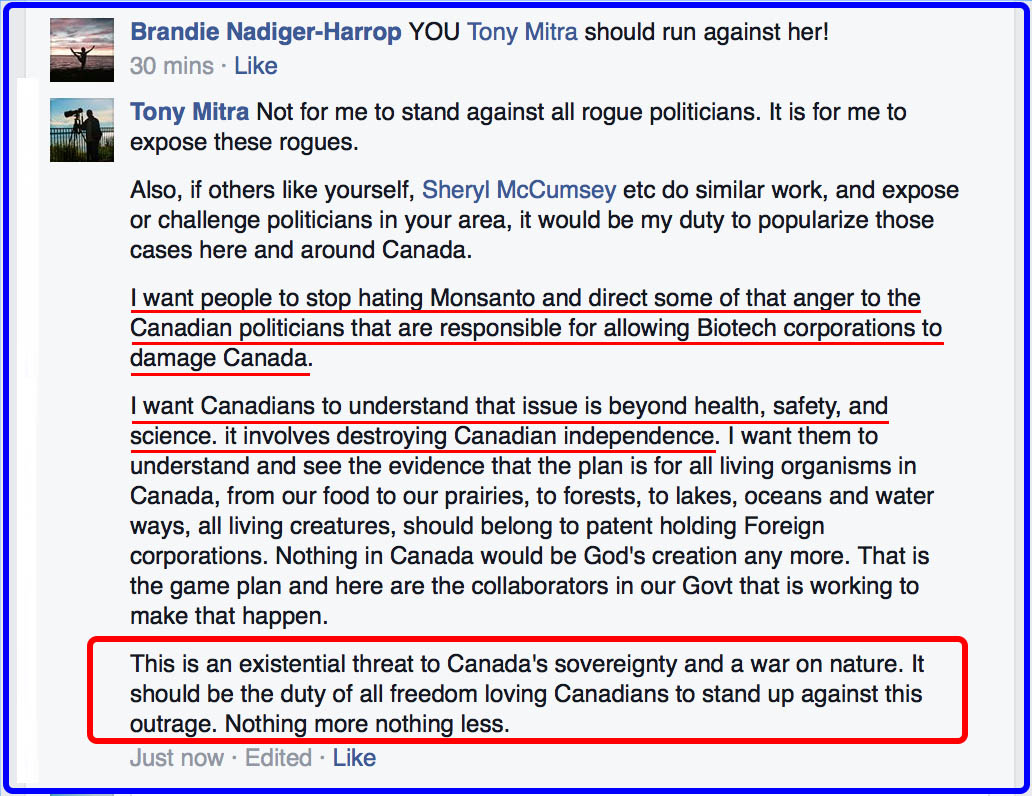
IT time Canadian politicians, starting from the bottom up, stop using ignorance as an excuse for doing nothing. It is time for them to stop passing the buck by blaming federal politics and claiming Municipalities have no authority. It is time for politicians to stop misguiding the public and obfuscate this issue. It is time for them to get off their high horse and face issues squarely and without hiding behind corporations and lobby groups.
Lori Mayhew gets my vote
Lori Mayhew is another candidate that responded in writing:
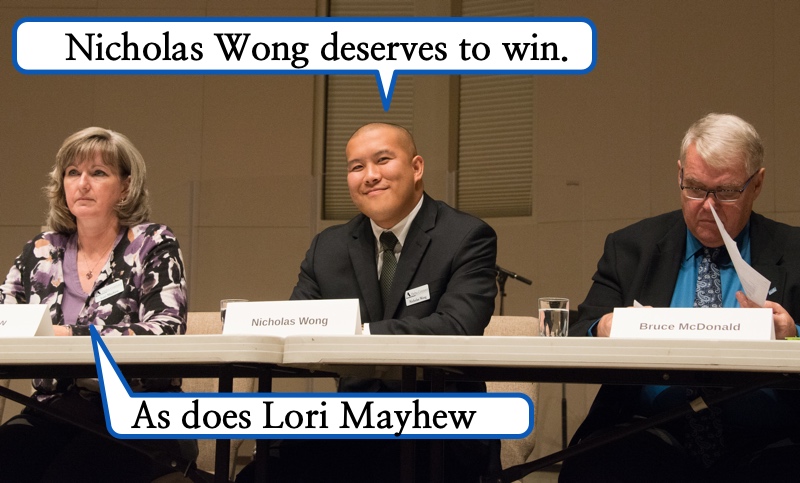
Nicholas Wong and Lori Mayhew get my vote.
Nicholas Wong gets my vote
Then there was Nicholas Wong. He responded : Hi Tony,
I have friends who have been directly effected by Monsanto and have developed cancer as a result of their pesticides. Farmers are particularly at risk from direct intoxication due to many of the pesticides and chemicals that they use. It stands to reason that this transfers into the food supply. This is not even touching on the issue of GMOs. I am not entirely certain that genetic manipulation is bad as a whole, but the way that the industries involved have refused regulation and surround themselves in secrecy is unacceptable. For that reason, I am entirely in support of having Delta join the list of municipalities declaring themselves GMO free. I will not support an indefinite ban, but, without proper health assessment and regulation, we have no way of protecting the population from its many potential harms and evils.
The facts you present are more than enough of a reason to support outlawing all GMOs until they pass sufficient health panels and demonstrate that they are not doing us irreparable harm. I hope that this answers some of the issues. Thank you so much for approaching me with the question and I will look for you in the crowd tomorrow. Thanks so much, Nicholas Wong ![]()
Johann Ackermann gets my vote
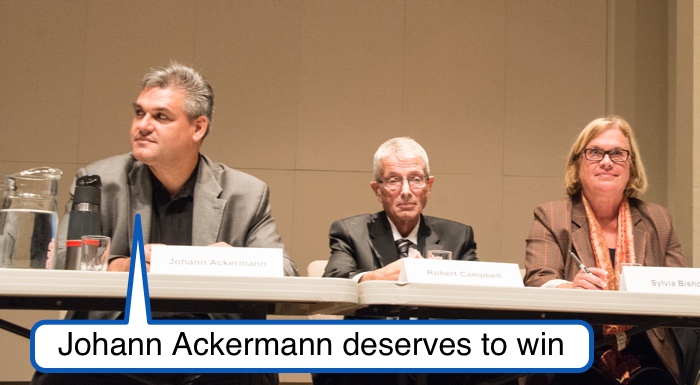
Johann Ackermann gets my vote
Not every candidate had time to respond to my original question in a day, but some of them responded later, such as in the morning of 24th October. Johann Ackerkann is one such and he was clear enough in his email. He mentioned Harold Steves, a hero in not only my eyes, but by an increasing number of Canadians in and outside of BC. He also mentioned that the shifty answer by Ian Paton blew him away. This is what he wrote: Tony,
Jennifer Thoss gets my vote

This screenshot received from Jennifer Thoss by email.
![]()
Ian Paton does not get my vote
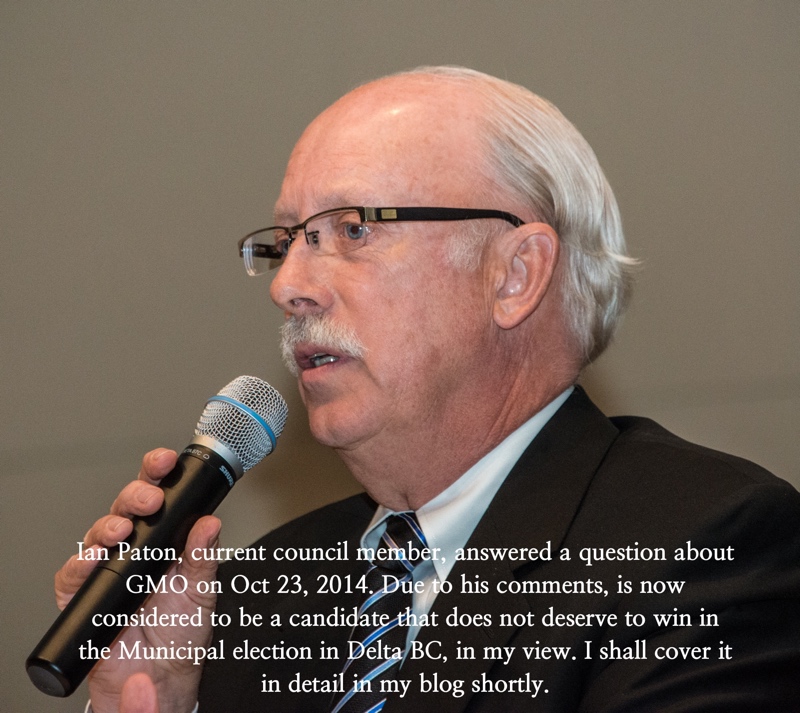
Ian Paton does not get my vote
Ian Paton was one that did not respond by email. However, the next day, October 23rd, during the Council Candidates meeting with the public – he did come across my question. I had penned the question to be fielded to the candidates – that many municipalities in BC had passed resolution to be GMO free, where BC lead the nation, but Delta was lagging behind. Would the candidate join the rest of BC and declare itself to be GMO free as well.Mr. Paton responded like a true politician – regretfully. In other words, he remained slippery and evasive, opting to support GMO labelling, which is not on the table in Canada, and he as a council member has no control over it. On the other hand, the item he has some control over, i.e. passing a resolution in Delta to be GMO free, he did not support it and considered such a resolution to be fluffy. So, supporting labelling, which is not on the horizon and which he cannot influence – is not fluffy, but the one he can do something about – is.
I personally have come across quite a few politicians that talk like that – promising nothing, committing to nothing, never taking a clear stand on issues, and wanting your vote nonetheless. Usually such politicians are to be found higher up in the hierarchy. It was surprising for me to come across such a one at the Municipal level. in my view, Ian Paton is a candidate that deserves to be an unemployed politician.
![]()
A response from Ian Paton :
Response from Harold Steves, Farmer and a Councillor, Richmond – who spearheaded the GMO free resolution in Richmond, and is still working on furthering the clean agriculture movement – and a hero not just for British Columbians, but concerned citizens across Canada. 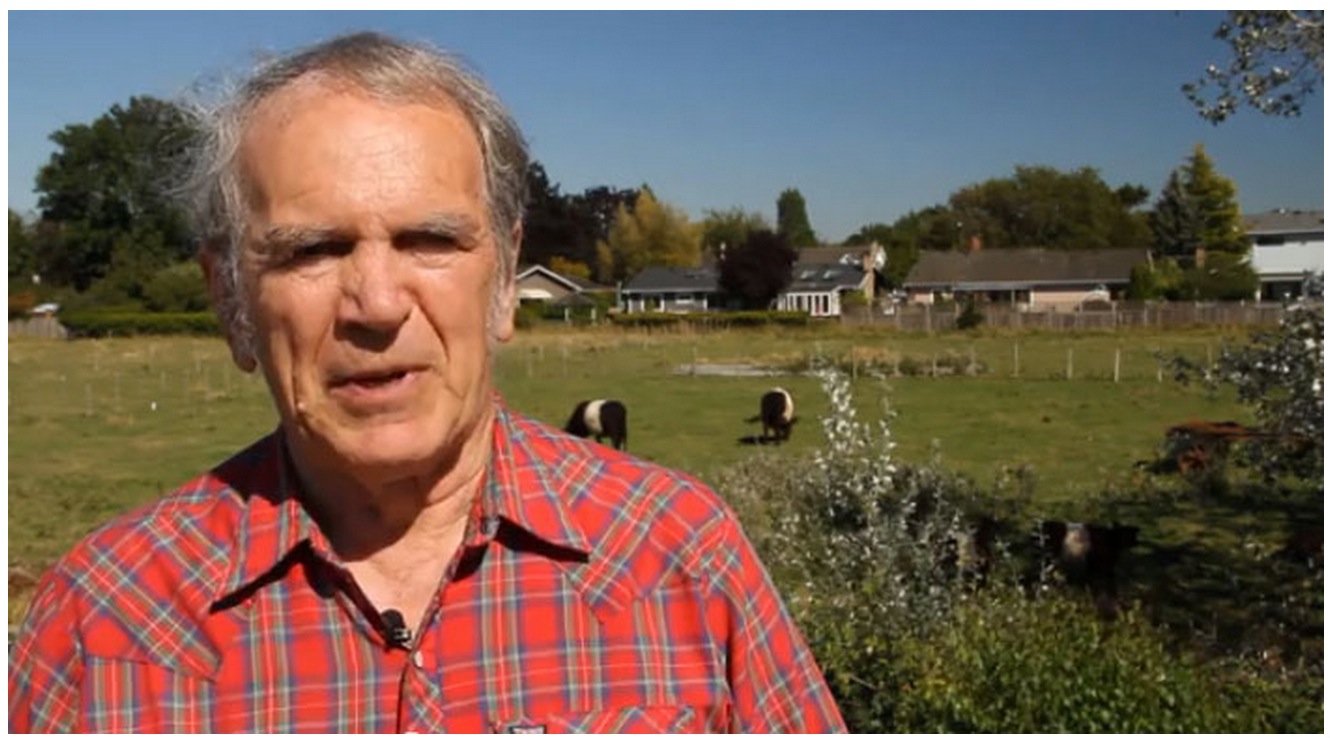 The Richmond “ban” on GMO’s has been immensely successful. The ban was not aimed at GMO cow corn that was already in production at a couple of dairy farms in Richmond. They were exempted as non conforming uses previously permitted.
The Richmond “ban” on GMO’s has been immensely successful. The ban was not aimed at GMO cow corn that was already in production at a couple of dairy farms in Richmond. They were exempted as non conforming uses previously permitted.
Chemical agriculture is the norm in the dairy industry. As the corn is used as silage to feed cows there is little chance that the chenical residues sprayed on the plants will get into the food chain outside of these farms.
The GMO ban was complimentary to Richmond’s ban on cosmetic pesticides. As 99% of GMO’s are designed for pesticide use banning both GMO’s and pesticides is doubly effective.
Richmond collects lawn clippings, leaves and other yard waste for composting through an anaerobic digester at Harvest Power in Richmond. Methane gas, normally produced by composting, is burned to produce electricity and CO2. The remaining compost is so clean and free of herbicides and pesticides that it can now be used on organic farms and gardens to produce food. At the same time an equivalent amount of CO2 is sequestered by the plants grown on the composted soil.
Vicky Huntington – Delta MLA was present

With Heather King & independent MLA Vicky Huntington
Independent Delta MLA Vicky Huntington was in the hall, introduced to me by Heather King. I had in fact had previous correspondence with Vicky, but only on email and twitter and never face to face. I had asked her about the use of RoundUp pesticide in Delta agriculture and the latest measurements of the level of Glyphosate in our soil and water, and the report that some farmers were overusing it in hope of killing super weeds and might be crossing the prescribed limit. I also asked about the issue that there are no labs in Canada that are geared to test out urine, blood and mothers breast milk, or our food such as wheat, corn, milk, cooking oil, bread, meat or processed food, for presence of Glyphosate.
Vicky had previously welcomed me to see her at her office, but I had not managed to find the time somehow. We decided we would catch up with each other soon. Anyhow, I reminded her that all my correspondence with her over the months and years have been always either GMO, or the herbicide RoundUp and its active ingredient Glyphosate, and its use in Delta farming, and the fallout from that in the health of the people that are involved in farming and those that live near the farm lands, and the wildlife that use the ground water, etc, and the question of if the city should monitor the toxicity level in our soil, water and especially in the crops that are sprayed with RoundUp. More on this later, on a some other blog, or podcast, or video. ![]() Thierry Vrain write to health minister Rona Ambrose
Thierry Vrain write to health minister Rona Ambrose
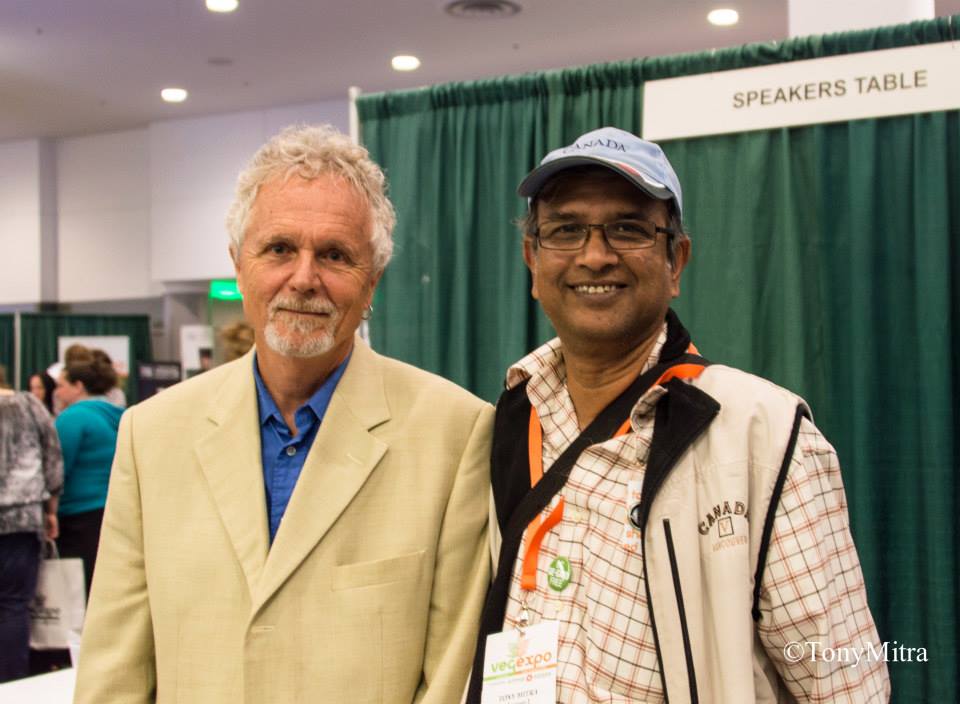 Meanwhile, my friend Thierry Vrain, retired genetic engineer, soil biologist, ex Agriculture Canada scientist and organic farmer as well as partner in our joint GE talk tour across Canada, is off to Ottawa to meet with Canada’s health Minister Ms Rona Ambrose to discuss GMO and pesticides in Canadian food and environment next Monday, Oct 27th.
Meanwhile, my friend Thierry Vrain, retired genetic engineer, soil biologist, ex Agriculture Canada scientist and organic farmer as well as partner in our joint GE talk tour across Canada, is off to Ottawa to meet with Canada’s health Minister Ms Rona Ambrose to discuss GMO and pesticides in Canadian food and environment next Monday, Oct 27th.
I have had past exchanges on email with Ms Abrose. These have not been encouraging from my point of view, but then I realize she is, in my judgment, incapable of and disallowed from making independent judgment on the safety of GMO and pesticide. Should she dare to do that, she will likely be fired on the spot. So, in effect, the minister is more like a face, a front, or a puppet, designed to make you feel good when you get to meet her or get an answer from her. Other than that, I do not believe she can or will change Canada’s policy of selling our rights, our food security and our seed freedom, to a handful of powerful foreign agro-industry corporations.
Nonetheless, I wish Thierry success, and am copying this email he recently sent to the minister, as a supplement to this page. It might prove educating to those that have the time to go through and decipher Thierry’s message.
To the Honorable Rona Ambrose, Minister of Health
A briefing paper on herbicide pollution and GMO labeling
from Dr Thierry Vrain:
Minister,
The confusion about the safety of GMOs is quite simple to address. The only GMOs in our agriculture are Glyphosate Modified Organisms also known as RoundUp Ready crops and the only GMOs in our food supply are from those crops. RoundUp Ready crops are engineered to be sprayed with the herbicide RoundUp and this technology has become so successful that RoundUp has become a major pollutant (1). This chemical pollution is antibiotic, it impacts the microbiome, impairs CYP enzymes, and depletes food of essential mineral micronutrients. As a background paper for the impact of this pollution I offer my speaking notes to the American College of Nutrition conference last week in San Diego (Texas). Most of the studies I cite were published in the last five years.
Glyphosate is the active ingredient of the herbicide RoundUp, a new molecule created in 1960 by Stauffer Chemicals – a US company with a business of cleaning industrial pipes and boilers of mineral scales. The mineral deposits (same as in electric kettles) are called scales, and the pipe cleaning chemicals are called descaling agents. Glyphosate was patented in 1964 in the US as a powerful and very broad spectrum descaling agent (2). Meaning, it binds to metals indiscriminately and does a great job at “dissolving and preventing minerals from being reactive or bioavailable in solution”. When the descaling solution was disposed of in nature, it was obvious that it killed plants. The chemical company Monsanto promptly bought the molecule, patented it as a herbicide in 1969, and got it commercialized in 1974 (3). This molecule is making history because glyphosate has become the most successful agricultural chemical in North and South America wherever RR seeds are used. The farmers using this technology get simpler and cheaper weed management and despite higher input bills and sometimes disappointing yields, and with weed resistance spreading fast, they adopted it in troves (4).
The herbicide RoundUp had a completely novel chemistry for a herbicide in 1969. It was deemed to kill plants by bonding to only one protein enzyme in the chloroplasts – the same enzyme that is also in bacteria and fungi. Enzymes are metalloproteins with a metal atom as a cofactor at the active site of the molecule. Bacteria and plants and fungi have a metalloprotein called EPSPS for short and 5-Enol Pyruvyl Shikimate-3 Phosphate Synthase if you want to know what it does. It works with other metalloproteins to “make” several of the building blocks of proteins, the aromatic amino acids. These molecules are also building blocks for a large number of aromatic molecules we call secondary compounds. Glyphosate binds tightly to the manganese atom at the centre of the EPSPS metalloprotein, so tightly that the protein cannot move and do its work making aromatic amino acids. No protein synthesis means there is no metabolic work possible, a quick death for the plant, or the fungi or the bacteria.
Animals do not make their own aromatic amino acids since they lack the shikimate pathway with the EPSPS metalloprotein. Because of its presumed mode of killing plants, glyphosate was pronounced innocuous to humans and registered as such in 1974 in the USA. Glyphosate has no acute toxicity, and at the time of registration in the US, and even since, nobody has bothered to check for chronic effects beyond 3 months. Considering the chemical properties of this pollution one would expect long term chronic effects, very similar to rickets, scurvy, or beri beri, for lack of micronutrients. The Industry sponsored feeding studies proving the safety of GMOs do not include testing for the safety of glyphosate. None of them bother to mention the residue levels of glyphosate in the feed. Meanwhile, a fast growing series of independent studies in various countries published in the last 5 years have ascertained the impact of glyphosate on various cellular enzymes and organs of animals and human cells.
The first RoundUp Ready crops to be commercialized were soy and corn, released in 1996. Since then, a handful of RR crops have been adopted enthusiastically by farmers, particularly in North and South America. Today close to 500 million acres of soya and corn, and cotton, canola, and sugar beet, are engineered to be sprayed with RoundUp. About 40% of all RR crops are grown in the USA, most of the rest are grown in Brazil, Argentina, Canada, and a few other countries. RR crops are now sprayed with close to two billion lbs of glyphosate every year, and so much of that finds its way into processed food and feed that the EPA had to raise the legal residue limits last year to accommodate a new reality (5).
Glyphosate is antibiotic, a powerful and broad spectrum antibiotic (6). The mode of kill is again alleged to be very selective. The glyphosate molecule impairs the functioning of the shikimate pathway in bacteria the same way it does in plants. Only one enzyme is affected in a pathway that animals do not possess. The antibiotic patent describes its effectiveness to kill bacteria at 1 ppm and this was confirmed last year in Germany (7). At this point I usually spend a minute or two explaining why a low level antibiotic diet for the rest of your life is not a good idea. I describe the recent interest of the medical field in a large joint research project involving many Universities to decipher the huge community of thousands of species of bacteria that call us home. The Human Microbiome project is the equivalent of the Human Genome project in its scope. We are vastly outnumbered, roughly ten to one – one hundred trillion bacterial cells call our lower intestine home. They are forever sending signaling molecules to each other and to all human organs, particularly the brain. All animals depend on their symbiosis with these bacteria, and humans are no exception. They are the teachers of our immune system, they make many neurotransmitters for our brain, and have a strong connection to the heart and the whole digestive tract. They literally feed us all kinds of molecules that we require – we call them essential, like vitamins and such. They digest and recycle most of our food. Most human organs rely on molecular signals from the microbiome for normal functioning. As goes the microbiome, so does its human shell. A recent review of the medical literature on celiac and other diseases shows the link to imbalances of the microbiome that are fully explained by the antibiotic properties of glyphosate (8). And the same authors published another review of the impact of glyphosate on the CYP enzymes and the microbiome. Samsel and Seneff have suggested that glyphosate’s suppression of CYP enzymes and its antibiotic effect on the human microbiome are involved in the etiology of many chronic degenerative and inflammatory diseases that have grown to epidemic proportions since 1996, since the advent of the RoundUp Ready technology (10).
We lack any official data on residues of glyphosate in food or in water in Canada – no epidemiological studies of any kind have ever been done. All we have are the legal maximum residue limits now allowed by the EPA in RoundUp Ready foods, human cereal 30 ppm, animal grain 100 ppm, soybean 120 ppm, and everything else in between (5). Here an inquisitive mind will ask why there is such a high residue limit for cereal when none of the grains are engineered to be sprayed with RoundUp. This is when you learn that RoundUp is sprayed on many non-engineered crops with the intent to kill them right before harvest. This is done to mature and dry the crops quickly to make them easier and cheaper to harvest. The RoundUp herbicide has now become a dessicant.
There is direct toxicity to animal cells because glyphosate binds to metals indiscriminately, and not just in plant cells. It binds to metals in solution and to metal co-factors at the centre of metalloproteins anywhere. For example glyphosate binds to the iron atom at the centre of a large family of protein enzymes called CYP. There are 57 different CYP enzymes in the human body, and approximately 20,000 in animals, plants, bacteria and fungi. The CYP enzymes are oxydizers, the first line of digestion and detoxification of most substrates. David Nelson wrote in a review of the CYP enzymes: “The CYP enzymes of humans are essential for our normal physiology and failure of some of these enzymes results in serious illnesses (9,10).
Nancy Swanson has made public her statistical analyses of the US Centre for Disease Control’s statistics about the health status of America when placed next to the statistics of the US Department of Agriculture about the spread of RoundUp Ready soy and corn. Her correlation analyses show very high coefficient values suggesting strong links between glyphosate residues in RoundUp Ready food and chronic illnesses (11).
Medical and chemical reviews and peer reviewed studies have explained the mode of action of glyphosate and its impact on many metalloproteins. Human cell studies have shown acute toxicity (12-15) and animal studies have shown chronic toxicity (16-21). Glyphosate bioaccumulates in the plants and in any animal that eat the plants.
Glyphosate accumulates in the lungs, the heart, kidneys, intestine, liver, spleen, muscles, and bones … and chronically ill people have higher residues in their urine than healthy people.”(22)
To conclude this presentation of the nutritional status of Glyphosate Modified Organisms, I would say that crops sprayed with RoundUp, whether they are RoundUp Ready or not, contain residues of glyphosate, that foods made from RoundUp Ready soy and corn and sugar and canola, etc … are depleted of the minerals that are bound to the glyphosate molecules (23). Foods made from crops containing residues of glyphosate are by definition depleted of minerals and toxic.
Minister, your reassuring words have been quoted widely. “Currently, there is no… scientific evidence, that says genetically modified foods are unhealthy. It is impossible for us to mandate a label, because our labels have to be based on evidence that it is an unhealthy product for Canadians.” I hope you have found here the scientific evidence you require to act and that you join over 60 governments in the world who have found this evidence compelling enough in the past few years, to legislate some form of protection from labeling to banning RoundUp Ready crops and the herbicide RoundUp.
Respectfully,
Dr. Thierry Vrain
Literature cited
1 Battaglin W.A., Meyer M.T., Kuivila K.M., Dietze J.E. 2014. Glyphosate and its degradation product AMPA occur frequently and widely in US soils, surface water, groundwater, and precipitation. J. Amer. Water Res. Assoc. 50, 275-290.
2 U.S. Patent 3,160,632 Stauffer Chemicals 1964
3 US Patent 3,455,675 Monsanto Chemicals 1969
4 Fernandez-Cornejo J., Wechsler S.J., Livingston M. and Mitchell L. 2014. Genetically Engineered crops in the United States. USDA Economic Research Report No. (ERR-162) 60 pp. http://www.ers.usda.gov/media/1282246/err162.pdf
5 EPA 2013 MCL (US Environment Protection Agency legal Maximum Contaminant Levels). http://www.epa.gov/ogwdw/pdfs/factsheets/soc/glyphosa.pdf
6 U.S. Patent Number 7,771,736 Monsanto Chemicals 2010.
7 Shehata, A.A., Schrödl, W., Aldin, A.A., Hafez, H.M. and Krüger, M. 2013. The effect of Glyphosate on potential pathogens and beneficial members of poultry microbiota. Curr. Microbiol. 66:350-358.
8 Samsel, A. and Seneff, S. 2013. Glyphosate, pathways to modern diseases II. Celiac sprue and gluten intolerance. Interdiscip. Toxicol. 6: 159-184
9 Nelson, D. 2013. A world of cytochrome P450s. Philo. Transac. Royal Soc. London B 368 No 1612.
10 Samsel, A. and Seneff, S. 2013. Glyphosate’s suppression of cytochrome P450 enzymes and amino acid biosynthesis by the gut microbiome: pathways to modern diseases. Entropy 15: 1416-1463.
11 http://www.examiner.com/gmo-in-seattle/nancy-swanson
12 Gasnier, C., Dumont, C., Benachour, N., Clair, E., Chagnon, M.C. and Séralini, G.E. 2009. Glyphosate-based herbicides are toxic and endocrine disruptors in human cell lines. Toxicology 262: 184-191.
13 Benachour N. and Seralini, G.E. 2009. Glyphosate induces apoptosis in human umbilical, embryonic, and placental cells. Chem. Res. Toxicol. 22: 97-105.
14 Koller, V.G., Fürhacker, M., Nersesyan, A., Mišík, M., Eisenbauer, M. and Knasmueller, S. 2012. Cytotoxic and DNA-damaging properties of glyphosate and Roundup in human-derived buccal epithelial cells. Arch. Toxicol. 86: 805-813.
15 Thongprakaisang, S., Thiantanawat, A., Rangkadilok, N., Suriyo, T. and Satayavivad, J. 2013. Glyphosate induces human breast cancer cell growth via estrogen receptors. Food Chem. Toxicol. 59: 129-136.
16 Senapati ,T., Mukerjee, A.K. and Ghosh, A.R. 2009. Observations on the effect of glyphosate based herbicide on ultrastructure (SEM) and enzymatic activity in different regions of alimentary canal and gill of Channa punctatus (Bloch). J. Crop Weed 5: 236-245.
17 Paganelli, A., Gnazzo, V., Acosta, H., López, S.L. and Carrasco, A.E. 2010. Glyphosate herbicides produce teratogenic effects on vertebrates by impairing retinoic acid signaling. Chem. Res. Toxicol. 23: 1586-1595.
18 Vecchio, L., Cisterna, B., Malatesta, M., Martin, T.E. and Biggiogera, M. 2004. Ultrastructural analysis of testes from mice fed on genetically modified soybean. Eur. J. Histochem. 48:448-454.
19 El-Shamei, Z.S.; Gab-Alla, A.A.; Shatta, A.A.; Moussa, E.A.; Rayan, A.M. 2012. Histopathological changes in some organs of male rats fed on genetically modified corn. J. Am. Sci. 8: 684-696.
20 Séralini, G.E., Clair, E., Mesnage, R., Gress, S., Defarge, N., Malatesta, M., Hennequin, D. and de Vendômois, J.S. 2014. Republished study: Long-term toxicity of a Roundup herbicide and a Roundup-tolerant genetically modified maize. Environ. Sci. Eur. 26:14
21 Clair. E, Mesnage, R., Travert, C. and Séralini, G.É. 2012. A glyphosate-based herbicide induces necrosis and apoptosis in mature rat testicular cells in vitro, and testosterone decrease at lower levels. Toxicol. in Vitro 26: 269-279.
22 Kruger, M., Schledorn, P., Schrodl, W., Hoppe, H.W., Lutz, W. and Shehata, A.A. 2014. Detection of glyphosate residues in animals and humans. Environ. & Anal. Toxicol. 4:2
23 Zobiole, L.H., Kremer, R.J., de Oliveira, R.S. and Constantin, J. 2012. Glyphosate effects on photosynthesis, nutrient accumulation, and nodulation in glyphosate-resistant soybean. J. Plant Nutri. Soil Sci. 175: 319
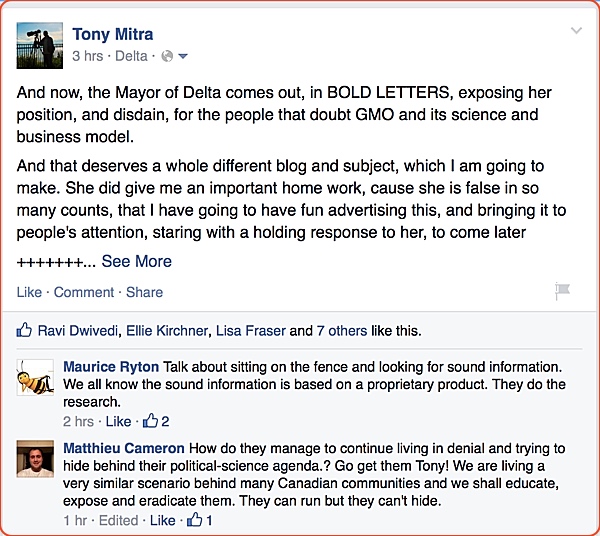
I shall fill this out more in the next few days. Watch this space.

